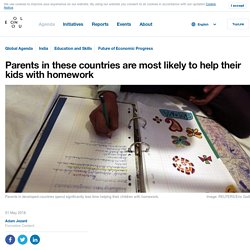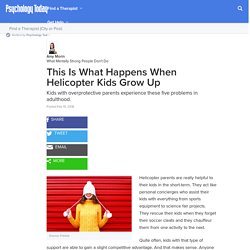

Living Workplace. Parents in these countries are most likely to help their kids with homework. If helping with homework is a measure of how much mothers and fathers care for their kids, then parents in India must be the most loving in the world.

Parents from the subcontinent provide the most assistance to their children, according to a new study. It also finds that parents in emerging economies spend more time helping children with schoolwork than those in richer nations. Globally, better-educated parents were the most likely to offer help, while 39% of those who had only been educated to primary level gave no help at all. These are some of the findings from a study of almost 27,500 parents in 29 countries by the Varkey Foundation, a charity that aims to improve the education of underprivileged children around the world.
Number of hours per week that parents spend helping children with studies. Image: Varkey Foundation. Which countries offer the most paternity leave? Earlier this summer, Virgin boss Richard Branson announced his company was offering new dads up to 12 months’ leave on full pay.

It’s clearly catching on: this week, Netflix introduced an unlimited leave policy for all parents, allowing them to take as much time off as they want in the first year after a child’s birth or adoption, on full pay. It’s a sign of the growing recognition that when fathers take time off to look after their newborns, it benefits them, their partners and their children. As an ILO report on parental leave noted, paternity leave has positive effects on the child’s development and helps break down traditional social attitudes of men as breadwinners and women as caregivers, which are damaging to both sexes. How can government support the modern family? You don’t need to be a demographic expert to know that the stereotypical nuclear family is no longer the norm; in fact, it is an artifact of a bygone era.

This is the difference women have made to their family's economic security. Overview The steady movement of women into the U.S. workforce over the past half-century has dramatically changed the composition of family incomes across the country and up and down the income ladder.

All these additional earnings, however, have not meant that family income has increased faster than in earlier eras. A breadth of research demonstrates that overall family economic security in the United States has been declining since the 1970s, especially among low- and middle-income families. As a result, even as more women have joined the labor force and families have lost their time for caregiving, too many families’ continue to face economic insecurity. This issue brief explores how over the past four decades, women’s increased earnings and increased annual hours of work have been essential as families across the United States seek to find and maintain economic security. Download File Women have made the difference for family economic security (pdf) What will the family of the future look like?
As we approach UN International Day of Families, only the foolhardy would try and predict the future of family groups.

Previous attempts have, in fact, failed. William J Goode, writing in the early 1960s during the “golden age of marriage”, saw convergence towards the western-style conjugal family as an inevitable consequence of industrialisation. No sooner had his seminal book World Revolution and Family Patterns been published than divorce rates started increasing, and married women began moving into the labour force. Nothing ventured, nothing gained, however. The post-WWII baby boom: fertility cycles and economic uncertainty. As the baby boom generation now reaches retirement age, concerns regarding the sustainability of our pension and health care systems are mounting.

The Real Play Coalition Value of Play Report. See web-page: Working Longer. People are having to work for to support longer retirements.

Flexible working practices and policies are emerging, but some employers continue to remain ambivalent about older workers. How parents spend their time when they're with their kids — Quartz at Work. Running a family is nothing if not a long exercise in multitasking: helping kids with homework while cooking dinner, staving off a toddler tantrum while pushing a grocery cart.

But just how much time with our kids is spent distracted by other tasks—or, looked at from a different angle, how often are we juggling kids while getting other chores done? The American Time Use Survey is a long-running study conducted by the US Bureau of Labor Statistics. It asks people detailed questions about how they spend their days. Recently released data from the survey shows that women spend more time with children in a typical day than men do.
But both mothers and fathers spend the bulk of their time with kids managing secondary tasks as well. Mothers spend nearly two hours a day cooking, cleaning, and doing other household tasks while simultaneously caring for kids; fathers do about 45 minutes. This Is What Happens When Helicopter Kids Grow Up. Source: Fotolia Helicopter parents are really helpful to their kids in the short-term.

They act like personal concierges who assist their kids with everything from sports equipment to science fair projects. They rescue their kids when they forget their soccer cleats and they chauffeur them from one activity to the next. Quite often, kids with that type of support are able to gain a slight competitive advantage. And that makes sense. The 3 Different Kinds of Helicopter Parents. Source: Fotolia I bet no one told your grandparents not to attend your parents' job interviews when they were 25.

1-2-3 Magic: Parenting Solutions using Positive Discipline from Dr. Thomas Phelan. Parenting Tips, Parent Advice & Kids Recipes. Fixing Our Relationship with Millennials. Ben Huh is the founder and CEO of The Cheezburger Network. The Millennial Generation (commonly defined as those born in the 1980’s and mid-1990’s) make up 27 percent of the US population and outnumber the Baby Boomers. Already, their economic clout is massive, and is projected to eclipse their parents’ generation in 2018. Brands are either desperate or salivating, depending on their current market positioning. Yet, understanding an entire generation is admittedly a guessing game and a pseudo-science. Family Structure.